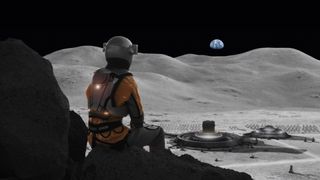Cosmic radiation during spaceflight could increase risk of erectile dysfunction in astronauts

The new era of human spaceflight is upon us with a crewed flight to the moon, on the Orion space capsule, scheduled for next year as part of NASA's Artemis II mission. This endeavor will only see astronauts reach lunar orbit, but is expected to pave the way for Artemis III, planned for Dec. 2025, a mission that will send crew members to actually step foot on the moon.
Not only will Artemis III see the first human presence on the moon's surface since 1972, but it will allow astronauts to spend seven days near the lunar south pole. Subsequent Artemis launches will also kickstart the possibility for even longer stays in space.
So, to ensure that humanity is fully prepared for those longer stays in space, which may eventually include long trips to Mars — it will take seven months just to travel to the Red Planet — scientists are investigating the effects of space on human health. And this includes experiments that focus on the effects of the space environment on sexual health.
- Vascular tissue impairment can also lead to erectile dysfunction, and the research indicated such dysfunction can persist even after astronauts return to Earth and undergo a long period of recovery.
"With manned missions to outer space planned for the coming years, this work indicates that sexual health should be closely monitored in astronauts upon their return to Earth," Florida State University's Justin D. La Favor, co-author of a paper on the findings, said in a statement.
Related: Can humans reproduce in space? Mouse breakthrough on ISS a promising sign
On Earth, humans are shielded from the high-energy charged particles that comprise cosmic radiation because of our planet’s magnetosphere. Astronauts on the International Space Station (ISS) are shielded artificially, though still receiving as much exposure in a week that a person at the surface of Earth would receive in a year.
Yet, when astronauts spend time on the moon and Mars, they will be far less effectively shielded from the particles.
Rather than expose humans to such radiation, and effective "weightlessness" which was the other concern, without enough preparation, Favor and the team conducted the first study to calculate the effect of galactic cosmic radiation and microgravity on erectile dysfunction prior to upcoming space missions.
"While erectile dysfunction affects more than half of men over the age of 40 and represents an important factor for life satisfaction, the consequences of space travel on erectile function are still obscure," the team wrote in a study about the results.
- Then, in analyzing the tissues of the rats a year later, Favor and colleagues found that even low exposure to cosmic rays had resulted in an increase in oxidative stress — which can damage cells, proteins and DNA.
- The team also found microgravity had a similar negative effect on erectile dysfunction, but that effect was less pronounced.
"While the negative impacts of galactic cosmic radiation were long-lasting, functional improvements induced by acutely targeting the redox and nitric oxide pathways in the tissues suggest that the erectile dysfunction may be treatable," Favor concluded.
A paper describing these results was published on Nov. 22 in the journal Federation of American Science for Experimental Biology (FASEB).
Join our Space Forums to keep talking space on the latest missions, night sky and more! And if you have a news tip, correction or comment, let us know at: community@space.com.



No comments:
Post a Comment